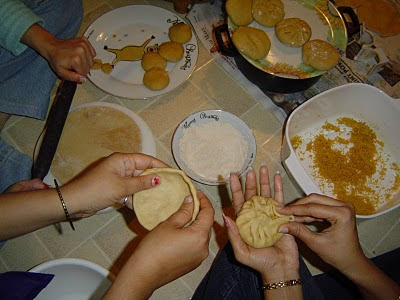Traditionally, the entire process of making Puran Poli was very social, where women gathered around and would discuss their problems or share their joys while preparing the dish.
In the design process, we can start with brainstorming sessions and interactive workshops which ‘engage’ the stakeholders, team members and end users to make the product create the ‘engaging experience’. We can also collectively derive at ‘Scenarios’ to capture the ‘social’ aspect of the product being designed.
A scenario talks about the user, situation and user’s goal. Let’s assume we are designing a mixer grinder (blender), one of our scenario can be ‘Mrs. Joshi and her friends want to make a traditional sweet dish for Ganesh Chathurthi. She needs the blender to help her prepare the sweet while talking to her friends’. Mrs. Joshi will then need a mixer which does not disturb the conversation with her friends. If so, then it needs to make very little noise so that it does not drive her friends away from the blender or disrupts the ‘engaging experience’
Engaging experience can be built iteratively by thinking on 'what features to have', 'how to implement' and 'when to implement'. Iterative design involves building the core essence of the product first and later building over and around the core essence in several sprints. Just like the puran poli where the ‘core’ is jaggery and channa dal, which gives the dish its taste.
The process of preparing the ‘core’ (Hoorna or Puran) begins with the right mixture of jaggery, channa dal and cardamom. This mixture can be eaten as is and is the bare minimum to be considered a sweet by itself. This is similar to KANO’s model of ‘Must haves’ in a product. So in the above scenario, the ‘Must haves’ of the blender is built around the features supporting the ‘quiet performance’.
Once the goals and scenarios to achieve the goals have been established, the next process is to divide these into iterations, on how to achieve the must-haves (core), the extended features and the delighters.
While making Puran poli, the next stage will be to use the core (Puran or Hoorna) as a filling. This is similar to the extended features the product will have around to enhance the ‘core’ or goal.
Here, we can re-validate our features which go around the product. Can it still be packaged as puran poli or if suddenly realize there are no right ingredients, can it be packaged as something else like Kadabhu (Karjai). Either ways, the core (jaggery+ channa dal) still remains the same.
In iterative design process the requirements may change over course of time, however the ‘goal’ of the user still remains the same. Eg: The blender instead of just being table top can now be combined with a micro-wave oven, so that it cooks while blending. Or, an application to help users get live traffic update can change from being a web application to a mobile application to better help users while driving. In both examples, the goal – ‘to provide quiet performance’ or ‘to get live traffic update’ remains the same as the ‘core’ filling of Puran poli or Kadabu.
Once the decision has been made, the next level of preparation begins. The Puran poli is fried and the product is ready to be packaged.
Finally, packaging the product is similar to serving Puran poli with ghee on top or serving it with milk on a banana leaf. The aroma creates the aspect of ‘delight’. Just like how products need to have ‘delighters’ or pleasant surprises which helps go beyond the basic necessities.
The core of the Puran poli can also be extended to other dishes. Usually the left-over hoorna is used for making a special rasam - Kattina saaru (in Kannada) or Kaatachi Aamti (in Marathi). The experience is extended as it is had after eating the sweet dish. Or, even if someone does not have the puran poli itself. This is similar to extending a product’s brand to other mediums. Eg: creating a section on Facebook or Twitter to market the product.
Throughout the entire process of preparing Puran Poli - from planning, cooking, to serving, and even eating it, is very interactive and social. These are the qualities we designers need to incorporate to make our design process more ‘engaging’ apart from providing an engaging experience to the end users. We need to ensure we engage our stakeholders and team members in all stages of our design process to decide on ‘what the product will have’ and ‘how to implement the product’.
Few methods a designer can use - User stories are helpful to begin and also draw boundary for conversation between team members. Creating story maps based on scenarios along with other team members can help decide how to iteratively develop the product. Interactive quick sketches by inviting other team members to sketch (if they wish) their ideas on top of our sketches or critique your sketches also leads the team to engage in your design and encourages to be expressive as well.Thanks to Swapna for sharing these awesome pictures on preparing the Puran poli. Recipes to make other delicious dishes can be found on her blog - http://swadofindia.blogspot.com/









No comments:
Post a Comment